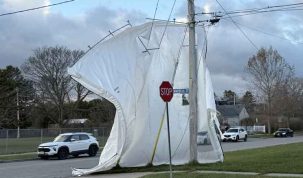By Cecilia Nasmith/Today’s Northumberland
The Ontario government is launching new 9-1-1 models of care to now cover 33 municipalities across the province, and the one announced Friday morning for the local community is the Treat and Refer Model for Palliative Care Patients.
A virtual press conference was held featuring representatives of participating municipalities – Kawartha Lakes, Durham Region, Haliburton County and Peterborough, in addition to Northumberland County.
Peterborough-Kawartha MPP Dave Smith explained the model of this pilot project.
“Prior to today, if anyone called 911 and the ambulance came, the only option was to take that individual to the hospital, even if the level of care they needed was not hospitalization,” Smith said.
“What we are changing to is a new model of care where paramedics who are appropriately trained will have different options. They will be able to take the individual to the level of care they actually need.
“Someone in palliative care may need team management, not a trip to the emergency room. It would be possible for the paramedics, in conjunction with other professionals, to deliver the care they need,” he explained.
“It alleviates some of the pressure on the emergency room, and it makes perfect sense. Why would you take an individual to the hospital who doesn’t need hospital care.
“It’s something that will create a better place for everybody involved, alleviate some of the challenge we have in the hospital with respect to overflow, will free up resources and will provide the appropriate level of care for the individual. It’s all focused on the individual.”
Peterborough and Kawartha Lakes Paramedics Chief Randy Mellow said the program is aimed at supporting palliative care patients as well as their family members and caregivers.
Care at home is the clear preference, Mellow said, but sometimes symptoms appear that prompt a 911 call. The paramedics assess, treat and take them to emergency – disrupting and distressing for both patients and family members.
He listed the most common such symptoms – nausea, vomiting, chronic shortness of breath, pain, hallucinations, agitation.
“We have no options at the present time other than treat the patient at their home and then take them to hospital for further evaluation.
“This allows us to bring the treatment to them, not the hospital – which is facing numerous other higher-acuity patients.”
For Northumberland residents, Northumberland Paramedics Chief Susan Brown said, this initiative builds on their Community Paramedicine Program, launched in 2020, as well as the establishment of a very strong Ontario Health Team network.
“This is another opportunity to improve patient and caregiver experience with the health-care system while decreasing pressure on our local hospitals,” Brown said, as well as a step toward ending hallway medicine.
Northumberland-Peterborough South MPP David Piccini characterized it as the right care at the right place at the right time.
“This is about patient-centred care,” Piccini stated.
Other models focusing on mental health are being launched elsewhere in the province, providing the option (for example) to deliver someone in a mental-health crisis to a crisis centre instead of a hospital.
“Taking someone in an extreme mental-health crisis into a very busy, hectic, loud emergency department is absolutely the worst place to take them,” Durham Deputy Paramedics Chief Jim Moir stated.
While these programs will not be a money saver, Smith said, the new model of care should lead to greatly improved outcomes for patients and more efficiency for beleaguered hospitals.
“We know the hospitals locally, at Durham Region, are facing unprecedented capacity pressures during the third wave of the pandemic,” Whitby MPP Lorne Coe said.
“We have been waiting a long time, but our government is delivering on these models of care, and it’s great to see such a big difference in providing the type of care vulnerable patients in our region have been waiting for.”
Campbellford Memorial Hospital President and Chief Executive Officer Varouj Eskedjian explained that anyone coming into the ER goes through the whole process of triage, assessment and tests.
“It really is not a waste of resources, but certainly the whole emergency team at that point would need to be working on this individual that may not necessarily require hospital care.
“Anybody coming in means extra wait time,” Eskedjian said.
“Many of these individuals, whether palliative or mental-health, may not want to come to the hospital,” Northumberland Hills Hospital President and Chief Executive Officer Linda Davis pointed out.
“Having the care go to them will make a big difference, a huge difference in having that care at the right time, not only decreasing the wait time in the emergency department but the number of patients that need to be admitted – because you are administering care at the right time and preventing that escalation of need.”
Davis noted that Northumberland’s population is primarily rural and, demographically, having a higher-than-usual senior population.
“The ability to take care to them is absolutely critical,” she declared.























